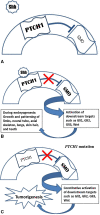Molecular and genetic aspects of odontogenic lesions
- PMID: 25409852
- PMCID: PMC4245404
- DOI: 10.1007/s12105-014-0588-7
Molecular and genetic aspects of odontogenic lesions
Abstract
In this article we outline the molecular findings of select odontogenic tumors. In each section, we briefly review selected the clinicoradiographic, histologic, immunologic features, focusing on the molecular findings and their applications in practice. The understanding of molecular pathobiology at various other organ sites has developed quite rapidly in recent years, however much remains unknown about the genetic profile of odontogenic tumors. Improved understanding of mutations in odontogenic tumors may clarify classification schema and elucidate targets for novel therapies. Molecular testing will no doubt improve our understanding of odontogenic tumor pathogenesis and will likely be, someday, an important component of routine clinical practice and its role will only increase in the coming years.
Figures



Similar articles
-
Adenoid Ameloblastoma Shares Clinical, Histologic, and Molecular Features With Dentinogenic Ghost Cell Tumor: The Histologic Spectrum of WNT Pathway-Altered Benign Odontogenic Tumors.Mod Pathol. 2023 Mar;36(3):100051. doi: 10.1016/j.modpat.2022.100051. Epub 2023 Jan 10. Mod Pathol. 2023. PMID: 36788106
-
Ameloblastin gene (AMBN) mutations associated with epithelial odontogenic tumors.Oral Oncol. 2004 Sep;40(8):841-6. doi: 10.1016/j.oraloncology.2004.03.004. Oral Oncol. 2004. PMID: 15288841
-
Diagnosing the most common odontogenic cystic and osseous lesions of the jaws for the practicing pathologist.Mod Pathol. 2017 Jan;30(s1):S96-S103. doi: 10.1038/modpathol.2016.191. Mod Pathol. 2017. PMID: 28060370 Review.
-
Malignant odontogenic tumors: an update on selected tumors.Head Neck Pathol. 2014 Dec;8(4):411-20. doi: 10.1007/s12105-014-0584-y. Epub 2014 Nov 20. Head Neck Pathol. 2014. PMID: 25409848 Free PMC article. Review.
-
Molecular pathology of odontogenic tumors.J Oral Pathol Med. 2006 Feb;35(2):65-74. doi: 10.1111/j.1600-0714.2006.00380.x. J Oral Pathol Med. 2006. PMID: 16430735 Review.
Cited by
-
Molecular Signaling in Benign Odontogenic Neoplasia Pathogenesis.Curr Oral Health Rep. 2016 Jun;3(2):82-92. doi: 10.1007/s40496-016-0085-z. Epub 2016 Mar 31. Curr Oral Health Rep. 2016. PMID: 27547697 Free PMC article.
-
Primary cilia and hypoxia-associated signaling in developmental odontogenic cysts in relation to autosomal dominant polycystic kidney disease - A novel insight.Heliyon. 2023 Jun 9;9(6):e17130. doi: 10.1016/j.heliyon.2023.e17130. eCollection 2023 Jun. Heliyon. 2023. PMID: 37389068 Free PMC article. Review.
-
Clear Cell Odontogenic Carcinoma Harboring the EWSR1-ATF1 Fusion Gene: Report of a Rare Case.Head Neck Pathol. 2020 Sep;14(3):847-851. doi: 10.1007/s12105-019-01103-4. Epub 2019 Nov 28. Head Neck Pathol. 2020. PMID: 31782119 Free PMC article.
-
Odontogenic Myxoma: Follow-Up of 13 cases after conservative surgical treatment and review of the literature.J Clin Exp Dent. 2021 Jul 1;13(7):e637-e641. doi: 10.4317/jced.58080. eCollection 2021 Jul. J Clin Exp Dent. 2021. PMID: 34306525 Free PMC article.
-
Expression of SOX2 and OCT4 in odontogenic cysts and tumors.Head Face Med. 2021 Jul 14;17(1):29. doi: 10.1186/s13005-021-00283-1. Head Face Med. 2021. PMID: 34261507 Free PMC article.
References
-
- Barnes L, Eveson J, Reichart P, Sidransky D. Pathology and genetics of head and neck tumours. Lyon: IARC Press; 2005.
-
- Muller S, Parker DC, Kapadia SB, Budnick SD, Barnes EL. Ameloblastic fibrosarcoma of the jaws. A clinicopathologic and DNA analysis of five cases and review of the literature with discussion of its relationship to ameloblastic fibroma. Oral Surg Oral Med Oral Pathol Oral Radiol Endod. 1995;79(4):469–477. doi: 10.1016/S1079-2104(05)80130-1. - DOI - PubMed
-
- Neville BW, Allen CM, Bouquot JE. Odontogenic cysts and tumors. Oral and maxillofacial pathology. 3rd ed. St. Louis: Saunders Elsevier; 2009. p. 678–740.
Publication types
MeSH terms
LinkOut - more resources
Full Text Sources
Other Literature Sources

